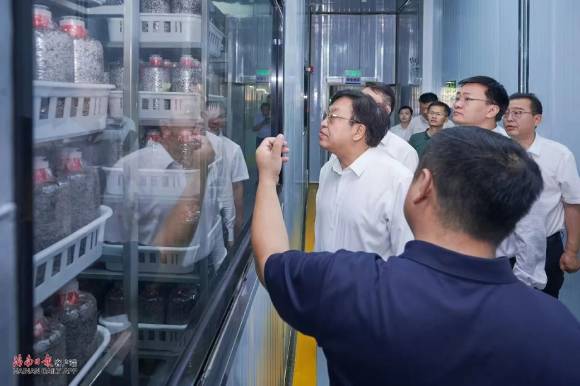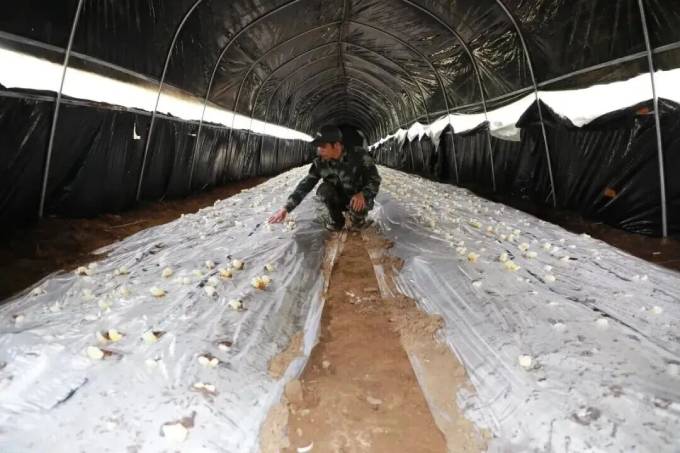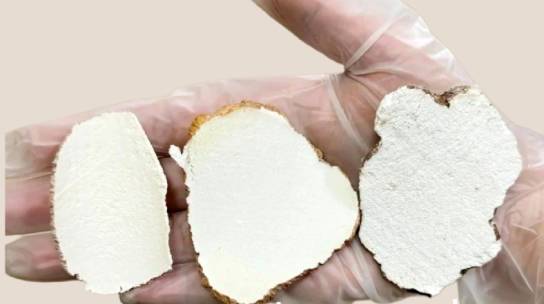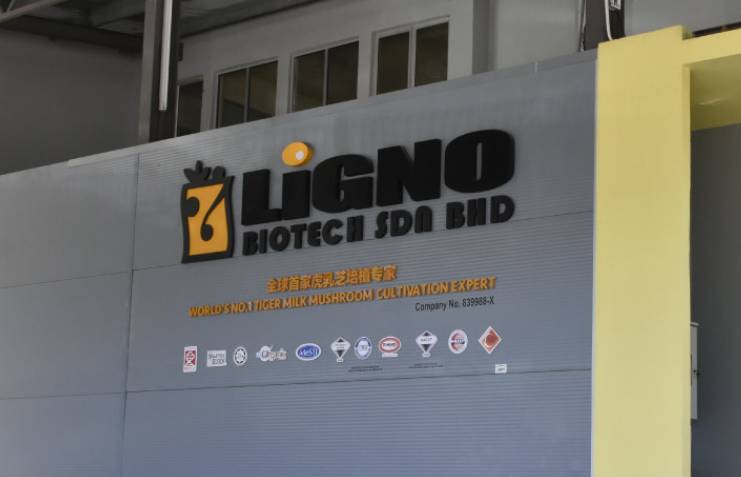Hainan’s Wild Tiger Milk Mushroom Thrives in Rubber Forests
A recent study by the Chinese Academy of Tropical Agricultural Sciences (CAATAS) confirms that Wild Tiger Milk Mushroom (Lignosus rhinocerus) cultivated under Hainan’s rubber forests is rewriting the ecological and economic landscape. This rare species of fungus through the “forest fungus symbiosis” mode, in the carbon sink efficiency and industrial income between the realization of a double breakthrough.
Hainan Tiger Milk Mushroom: An Ecological Treasure under the Rubber Forest
In the 1950s, in order to break through the international blockade and ensure the self-sufficiency of strategic resources, China initiated the “Rubber Northward” project, expanding rubber cultivation from traditional tropical areas (such as Southeast Asia) to areas north of 18°N latitude. Hainan, with its unique geographical location, became the core test area of the project. Despite facing natural challenges such as cold waves and typhoons in the early days, Hainan has finally realized large-scale rubber planting and laid a solid foundation for its rubber industry by continuously improving planting techniques (such as building windbreak belts) and cultivating stress-resistant varieties (such as the “Thermal Research 879”).
Rubber forest is not only an important production base for national strategic materials, but also its carbon sink function has been gradually re-recognized. According to the Chinese Academy of Thermal Sciences, Hainan rubber forests absorb about 1.8 million tons of carbon dioxide per year, with a carbon stock as high as 27 million tons, which has a huge potential to participate in the international carbon trading market. This ecological value and the superposition of economic benefits, such as under-forest economy and other modes, so that the rubber forest has become a typical carrier of Hainan will be “green mountains” into “mountains of gold and silver”.
Among them, the Tiger Milk Mushroom industry has developed rapidly in recent years, becoming the highlight of the rubber forest economy. Tiger Milk Mushroom, scientifically known as Ling Ling Nucleated Stalk Mushroom, is a precious species in the tropical rainforest because its nucleus resembles tiger’s milk. Its growth needs to meet three major conditions: high temperature and high humidity microclimate, diffuse light sheltered environment, and humus-rich soil. Hainan Island’s tropical monsoon climate (average annual temperature of 25°C, annual precipitation of 1500-2000 mm) and vast rubber forests provide an ideal habitat for this species.

Planting Tiger Milk Mushroom under Rubber Forest
01 Ecological Compatibility, Nurturing Treasures
As the main economic forest in Hainan, the understory of the rubber forest has long been unused. However, the tall rubber tree canopy forms a natural sunshade, fallen leaves accumulate and decay into fertile humus, and the forest is well ventilated with stable humidity. These seemingly ordinary ecological conditions have become a “golden growing zone” for Tiger Milk Mushroom. This “symbiosis” model not only avoids the development and destruction of the native rainforest, but also activates the multi-dimensional value of the rubber forest, allowing Tiger Milk Mushroom to thrive in a “semi-wild” state, and become a natural “nutrient reservoir”.
Tiger Milk Mushroom, as a saprophytic fungus, skillfully utilizes the fallen leaves and root secretions of rubber trees as a source of nutrients to build a unique micro-ecosystem under the forest. The broad leaves of the rubber tree shield the Ganoderma lucidum from the strong tropical sunlight, creating a moist and cool growing environment; while the Ganoderma lucidum provides a natural nutrient cycle for the rubber tree in the process of decomposing organic matter. Hainan’s pioneering “forest fungus symbiosis” model has become a model for practicing the “Two Mountains Theory”. Tiger Milk Mushroom planted under the rubber forest, not only without new land, but also through the residue of fungus to enhance soil fertility, promote rubber yield increased by 20%, Puzzle income 500 yuan / mu. With the “one water, three nutrients” system (nourishing rubber, puzzle, ganoderma lucidum) of Hainan Baisha base, the synergistic amplification of ecological and economic benefits can be realized.
This in Hainan forest “imitation wild planting” Tiger Milk Mushroom, its polysaccharide content of up to 8%, higher than other common varieties (such as Malaysia Tiger Milk Mushroom), which makes the Hainan Tiger Milk Mushroom in the market has a very strong competitiveness, and has become a high-priced bidding for the core products.
02 Forest Mushroom Intercropping, Circular Economy
The “ecological code” of Tiger Milk Mushroom industry lies in its unique circular economy model. Tiger Milk Mushroom mycelium releases nitrogen, phosphorus, potassium and other minerals during the decomposition of organic matter, and the residue of the fungus is converted into natural organic fertilizer after tilling, which feeds the growth of rubber trees and puzzles.
Hainan Baisha Tiger Milk Mushroom planting base, for example, “rubber + puzzle + Tiger Milk Mushroom” composite planting model has achieved remarkable results. Growers will be buried under the rubber forest, the bacteria to absorb the bag of cottonseed husk, soybean meal and other substrate nutrients, after the growth of the residue directly to the field. These seemingly discarded mushroom sticks, after crushing, are rich in lignin, cellulose and trace elements. As the waste after Tiger Milk Mushroom planting, the mushroom residue can be processed and returned to the rubber forest as a high-quality organic fertilizer, which significantly improves soil fertility, equivalent to 2.5 tons of organic fertilizer per mu, and significantly enhances the activity of soil microorganisms.

Tiger Milk Mushroom with Umbrella
Specifically, the beneficial microorganisms in the crumb can break down the solidified nutrients in the soil and increase the absorption rate of phosphorus, potassium and other elements by the rubber trees; at the same time, the porous structure of the crumb enhances the ability of the soil to retain water and fertilizer, and improves soil compaction caused by long-term monoculture rubber planting. Healthy soil is also conducive to the growth of Tiger Milk Mushroom, forming a mutually reinforcing and synergistic ecological cycle. This process not only reduces the use of chemical fertilizers, but also lowers the cost of cultivation, truly realizing a “zero-waste” cycle.
This “Rubber + Puzzle + Tiger Milk Mushroom” composite planting system builds a three-layered three-dimensional economic framework: the upper layer of rubber trees provides shade and an ecological barrier, the middle layer of puzzles (Chinese medicines) grows by utilizing the gaps between the forests, and the lower layer of Tiger Milk Mushroom absorbs nutrients by rooting itself in the humus soil. According to the research data of Baisha Lishu Company, rubber forests applying organic fertilizers with mushroom residue for three consecutive years, the soil porosity increased by 15%, the annual growth of rubber trees increased by 12%, and the understory of puzzles increased by 500 yuan per mu, which formed the closed loop of “fertilizer nourishes the forest – forest optimizes the fungus life”.

Feng Fei, Secretary of Hainan Provincial Party Committee, inspected Tiger Milk Mushroom plantation base.
03 Revitalizing Hainan’s Economy from “Helping” to “Wealth Creation
Driven by policy, the Tiger Milk Mushroom industry in Hainan is transforming from “rough cultivation” to “technology-driven”, forming a closed loop of innovation from “university R&D – enterprise transformation – farmer participation”. This transformation has brought significant economic benefits to Hainan, and has become an important force for local economic development.
Baisha County, for example, the traditional rubber planting mu average annual income of only 1,200 yuan, and sets of Tiger Milk Mushroom after the mu average output value jumped to 28,000 yuan, net profit of more than 6,000 yuan. According to media reports, Mr. Fu, a rubber farmer, used 15 acres of rubber forest to plant Tiger Milk Mushroom and made a profit of 90,000 RMB in a single 6-month planting cycle, far exceeding the income from traditional rubber cutting.
The development of the Tiger Milk Mushroom industry not only increases farmers’ income, but also leads to the development of related industrial chains. From planting, harvesting to processing, the industry requires a lot of manpower, providing employment opportunities for local farmers. For example, the industry has provided nearly 200 permanent jobs and 90,000 temporary jobs for left-behind villagers, and the annual per capita income has increased from 2,000 yuan to 24,000 yuan, which has helped the village move from “hollowing out” to “revitalizing”.
Tiger Milk Mushroom provides employment for local farmers.
At the same time, Hainan University School of Pharmacy team signed a contract with Bayshah Lishu Company, invested 10 million yuan to carry out Tiger Milk Mushroom health functions and medicinal value of research and development, focusing on polysaccharide extraction, immune regulation mechanism and other issues. In response to the industry’s pain point of “small, scattered and weak”, the Hainan Forestry Research Institute and the Jiu San Society have jointly carried out technical training, covering nearly 100 farmers in Qingsong Township and other bases, realizing the goal of “knowing how to plant, being able to afford to plant, and being able to increase income”.
More noteworthy is that this ecologically friendly planting model in addition to the promotion of Bisha, but also in Baoting, Wuzhishan and other cities and counties in Hainan to form a large scale, driving the employment of farmers and the revitalization of the local economy. At the same time, Tiger Milk Mushroom industry development has spawned a deep-processing industry chain, from ganoderma lucidum spore powder to health food, the added value of the product continues to improve, out of a “ecological priority, green development” of the new path.
By the end of November 2024, the forest economy in Hainan province covered an area of 1.3 million mu, with an output value of about 6 billion yuan. Forest economy has become the people’s hands “green bag of blessings”, proving that ecological protection and economic development is not a zero-sum game, but through innovative models to achieve synergistic co-progress. When the Tiger Milk Mushroom and other mushrooms grow quietly under the rubber forest, Hainan is using ecology as a pen to write a new chapter of “green wealth and prosperity”.

Tiger Milk Mushroom centralized drying
From the laboratory to the industrial chain, the Tiger Milk Mushroom industry in Hainan has formed a complete ecological closed loop. This rare species of wild mushrooms growing under rubber forests is becoming an innovative model for global sustainable agriculture – data for 2024 shows that it will drive an output value of 6 billion yuan, verifying the synergistic potential of ecological protection and economic development.






I have been surfing online more than 3 hours as of late, yet I never discovered any interesting article like yours. It is lovely price sufficient for me. In my opinion, if all webmasters and bloggers made excellent content material as you did, the net shall be much more helpful than ever before.
Dikkatli , keyfinizi güvenceye alır .
Продвинутые .Точность фиксации минимизирует. операции с минимальными усилиями .
Freight delivery from China is trustworthy and fast.
Our company offers flexible solutions for companies of any capacity.
from china hainan
Clients value our professional team and competitive rates.
Choosing us means assurance
Это быстро открывать нужную информацию.
легко сохранить .
On website can discover a lot of helpful information.
It is help me with topics. easy-to-read
Многие сервисы , что увеличивает доверие покупателей.
Подбор профессиональной техники — серьёзный шаг в развитии салона.
Сначала стоит понять задачи и услуги, которые собираетесь оказывать.
Необходимо изучить разрешения и производителя выбранного аппарата.
Отзывы опытных специалистов помогут принять осознанный выбор.оборудования поможет повысить качество процедур.
portray natural harmony in an respectful way.
value such work for its emotional power.
This style into something truly timeless.